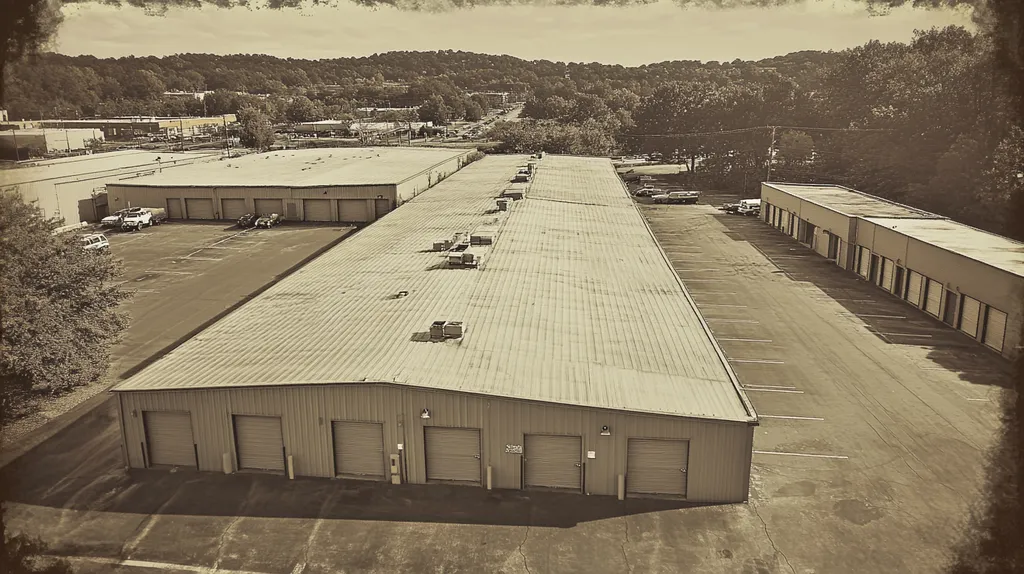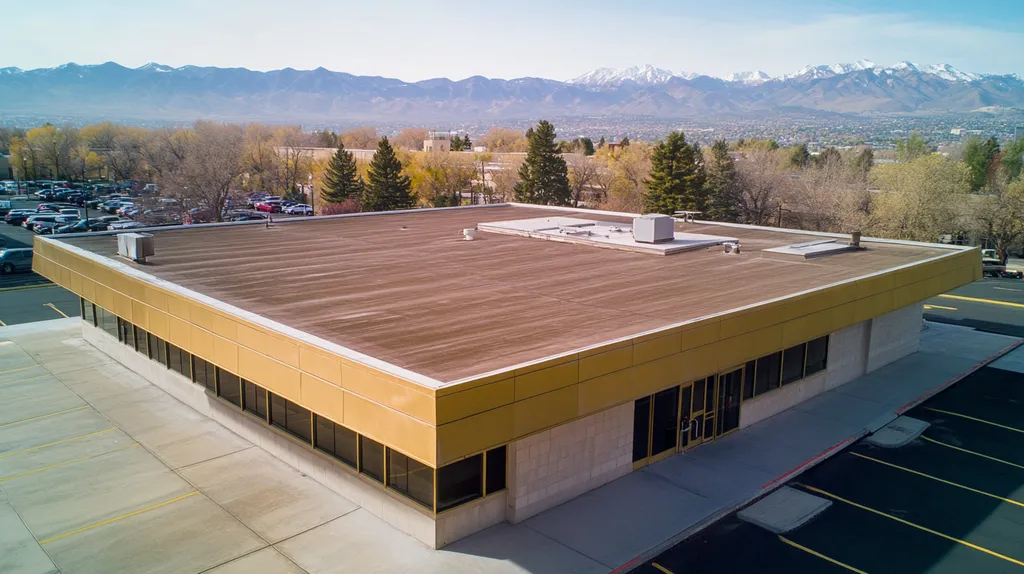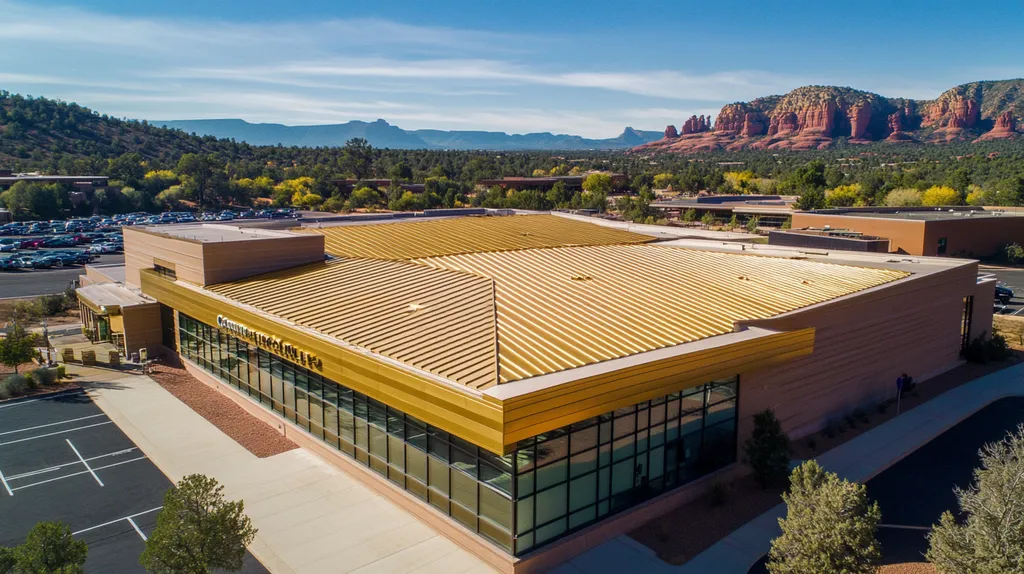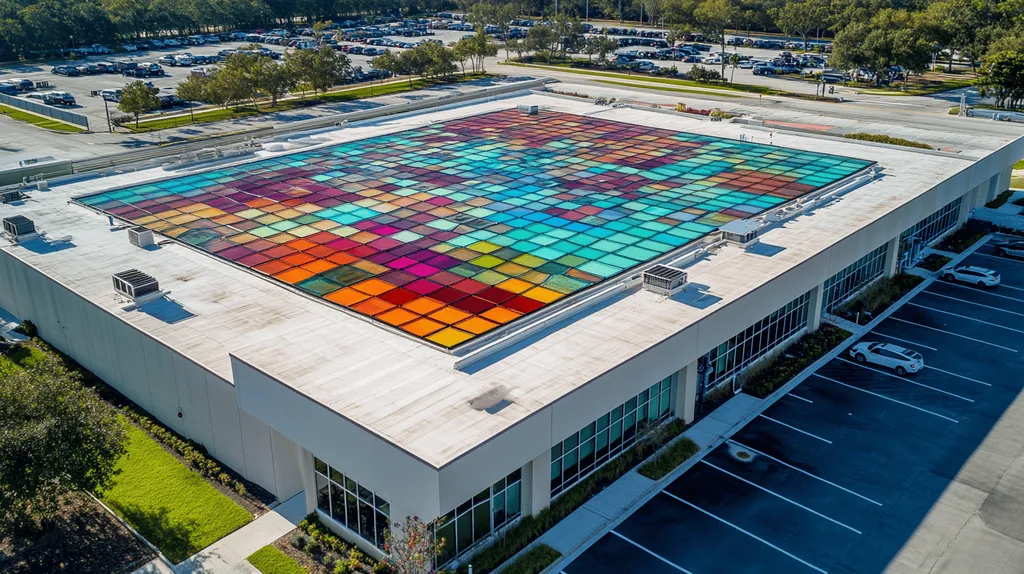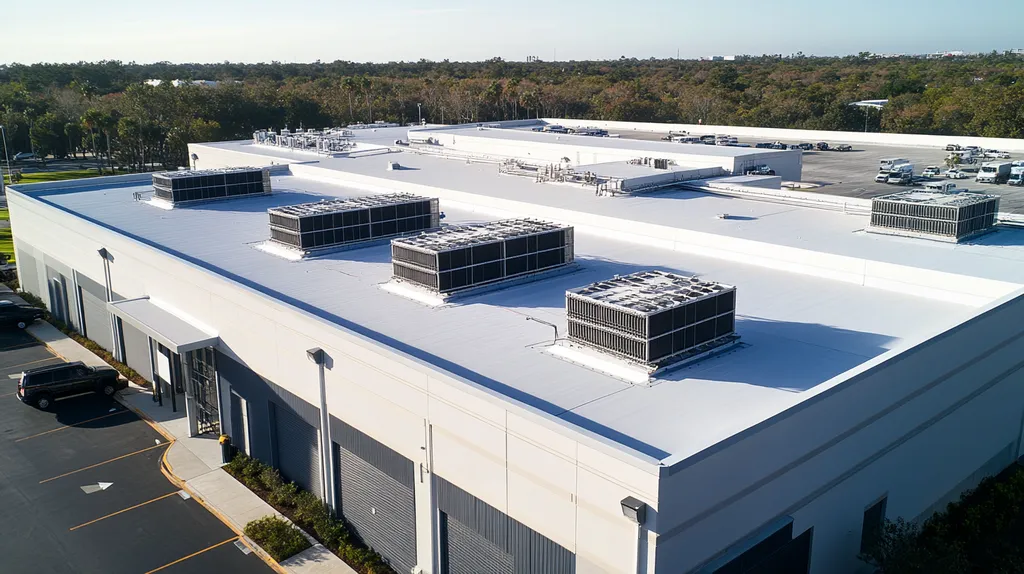In today’s commercial buildings, UV radiation silently destroys roofing systems, causing an estimated $3.3 billion in annual repair costs across North America. Research shows that inadequate UV protection can reduce a roof’s lifespan by up to 40% while increasing cooling costs by 25%.
For property owners and facility managers, understanding UV resistance has become a critical priority that impacts everything from energy efficiency to regulatory compliance.
This comprehensive guide examines the performance factors, financial implications, and operational procedures needed to ensure effective UV protection in commercial roofing systems.
SECTION 1: PERFORMANCE FACTORS
UV radiation is a hidden enemy for commercial roofing systems, threatening to undermine their performance and durability. Research from the National Roofing Contractors Association indicates that exposure to UV rays can diminish the lifespan of roofing materials by 20% or more. For property owners and facility managers, understanding the effects of UV on roofing is vital for making informed choices that protect their investments and enhance sustainability.
Impact of UV on Roofing Materials
UV radiation can degrade roofing materials over time, severely compromising their efficiency. For instance, materials such as PVC, TPO, and EPDM can suffer from oxidation, leading to brittleness and cracks that affect not only appearance but also waterproofing capabilities.
A study from the American Society for Testing and Materials revealed that TPO roofs might lose up to 50% of their tensile strength after extensive UV exposure. This erosion of strength increases the risk of seam failures, which can result in leaks and costly water damage.
Regular inspections for UV damage can help property owners identify problems early, allowing for timely repairs and interventions to maintain roof performance. Furthermore, UV exposure can cause roofing surfaces to fade and discolor, which reduces sunlight reflection and raises cooling costs.
Key Action Items
Thermal Shock and Expansion
Thermal shock, driven by UV radiation, is a crucial factor in roofing performance. As temperatures change throughout the day, roofing materials expand and contract, which can weaken the adhesion and integration of different roofing components.
When roofs lack proper UV resistance, the accumulated thermal stress can accelerate material fatigue, potentially causing buckling or seam splits that compromise overall integrity.
Frequent thermal cycling can introduce cracks and separations that may lead to moisture intrusion, resulting in insulation damage and mold growth. This poses serious health concerns and financial implications for property owners.
Choosing materials engineered to withstand thermal fluctuations, such as advanced coatings and reflective membranes, can significantly mitigate thermal shock effects and enhance roof durability.
Key Action Items
UV-Induced Structural Degradation
Long-term UV exposure can lead to structural degradation that affects more than just surface materials. Essential components like insulation and substrates may deteriorate, undermining the entire roofing system over time.
For instance, polyiso insulation, frequently used in commercial roofing, can experience degradation from prolonged UV exposure, threatening the stability of the roofing structure.
Moreover, persistent UV radiation can weaken the bonds between roofing layers, increasing susceptibility to failures during extreme weather. An unbonded roof is at a significantly higher risk of catastrophic damage.
To counteract these issues, it is paramount to select roofing materials with inherent UV-resistant properties. Establishing a comprehensive maintenance plan will also support the long-term structural integrity of the roof.
Key Action Items
SECTION 2: FINANCIAL CONSIDERATIONS
Addressing ultraviolet (UV) resistance in commercial roofing is not only a matter of durability but also a crucial financial decision. Ignoring UV protection can lead to soaring energy costs and the necessity of premature roof replacements. Research indicates that roofs lacking UV-resistant coatings may absorb up to 25% more heat, dramatically increasing energy bills. For property owners and facility managers, recognizing the financial ramifications is essential to safeguarding their investments.
Cost Savings Through Energy Efficiency
Investing in UV-resistant roofing materials can lead to remarkable energy savings. These roofs efficiently reflect solar energy, maintaining cooler temperatures inside buildings during the hotter months.
This reduction in reliance on air conditioning can significantly cut energy bills, with energy-efficient roofing systems capable of lowering cooling costs by as much as 30%. Thus, the initial investment in UV protection can yield valuable returns over time.
Embracing energy efficiency not only reduces operational expenses but also demonstrates a commitment to sustainable practices, which is increasingly important for communities and the environment.
Key Action Items
Extended Roof Lifespan and Maintenance
UV resistance is vital for extending the lifespan of roofing systems. Without adequate protection, roofs are prone to damage from the sun’s harmful rays, resulting in issues such as cracking and rapid degradation.
A roof designed with UV-resistant features can last 20-30% longer, minimizing the frequency and expense of replacements. This added longevity allows businesses to maintain seamless operations without interruptions.
Moreover, reduced maintenance needs translate to lower ongoing costs. Continuous repairs can be burdensome, especially for roofs exposed to harsh elements without proper UV protection.
Key Action Items
ROI on UV-Resistant Coatings
The return on investment (ROI) for UV-resistant coatings is remarkably strong for commercial properties. These coatings enhance roof protection while simultaneously increasing property value.
Research indicates that properties equipped with UV-resistant coatings can achieve a 50% return on their initial investment. This financial benefit arises from lower energy costs and enhanced roof durability, ultimately impacting property valuation positively.
Additionally, visible improvements in energy efficiency can attract prospective tenants or buyers who prioritize sustainability. As the market increasingly favors environmentally responsible developments, investing in UV protection becomes a savvy financial strategy.
Key Action Items
SECTION 3: COMPLIANCE REQUIREMENTS
The need for strong UV resistance in commercial roofing goes beyond durability; it is now a critical compliance issue. Property owners must navigate the increasingly complex regulatory landscape to avoid legal challenges and financial burdens. Regulations surrounding UV exposure are not merely red tape; they are essential for preserving property value and ensuring safe buildings. This section will outline the key compliance requirements that impact roofing practices.
Regulatory Standards for UV Protection
Regulatory standards focusing on UV protection are tightening as awareness grows around long-term roofing performance. These standards aim to limit environmental impact while ensuring roofing materials endure UV exposure effectively.
The National Roofing Contractors Association (NRCA) sets forth guidelines outlining acceptable UV resistance levels for various roofing materials. Adhering to these standards is often essential for maintaining warranties, making compliance vital for property owners.
Non-compliance can result in serious consequences, including fines, required repairs, or legal problems. Staying updated on evolving standards ensures that roofing choices meet necessary requirements and enhances longevity through smart initial selections.
Key Action Items
Building Codes and Local Ordinances
Building codes and local ordinances significantly influence roofing practices within different regions. Each area may impose specific guidelines concerning UV resistance that must be followed to ensure compliance and public safety.
Cities often implement regulations about reflective roofing materials to boost energy efficiency. Ignoring these guidelines can lead to fines or project holdups, making it crucial for property managers to engage with local authorities prior to any roofing project.
Moreover, local codes are subject to change, including new UV resistance requirements. Keeping apprised of these updates enables property owners to remain compliant and contribute to sustainable building efforts.
Key Action Items
Environmental Compliance and Certifications
Environmental compliance has transitioned from mere legal necessity to a crucial standard driven by sustainability. Certifications like Energy Star and LEED are important benchmarks for assessing UV resistance in roofing systems.
These certifications often require documentation of roofing material performance under UV exposure, along with their environmental impact. Properties meeting these standards can gain tax incentives and increased property value, making compliance financially savvy.
Additionally, the industry’s shift toward green construction emphasizes the importance of incorporating UV-resistant features into roofing systems. By aligning with these certifications, property owners showcase their commitment to sustainable building practices, reinforcing their market position.
Key Action Items
SECTION 4: RISK MANAGEMENT
Managing the risk factors associated with UV damage is essential for property owners and facility managers. UV rays, particularly in sunny climates, can cause significant deterioration of roofing materials, leading to costly repairs and potential safety hazards. Failure to address these risks results in premature aging of roofs, leading to leaks and structural integrity issues. Proactively identifying and managing these risks is crucial for protecting both the building and its long-term value.
Assessing UV Damage Risk Factors
Understanding UV damage risk starts with evaluating the type of roofing material. Certain materials like TPO and PVC have better UV resistance, whereas others may need complementary treatments. Local climate plays a significant role; regions with high sun exposure face greater risks of heat-related damage.
Conducting regular inspections is critical. Property managers should be vigilant for signs of UV degradation, such as cracks, blisters, or fading. Reflective testing on lighter-colored roofs helps determine effectiveness in deflecting UV rays.
A routine maintenance schedule is key to extending roof life. Regular cleaning and re-coating can address minor issues before they escalate, significantly reducing risk. Taking a proactive approach to risk assessment can enhance a roof’s longevity and safeguard against future hazards.
Key Action Items
Preventing Leaks and Water Damage
UV degradation frequently leads to leaks and water damage. Over time, the protective outer layer of roofing materials can break down, exposing underlying layers to moisture, which can result in mold and structural issues.
To prevent leaks, it is essential to use UV-resistant materials during installation. Adding protective coatings can further enhance a roof’s ability to resist water and maintain UV protection. Consider using specialized systems designed specifically for leak prevention.
Regularly inspect seams and joints, as these are common sources for leaks. Proactively repairing these vulnerable areas can save on significant water damage costs. Effective drainage systems must be in place to prevent water pooling, which accelerates UV-related degradation.
Key Action Items
Mitigating Heat-Related Roof Failures
Heat-related roof failures can result from continuous UV exposure. The expansion and contraction of materials due to heat can lead to fatigue and potential failure. Choosing materials with higher thermal resistance is key to mitigating these issues.
Using reflective roofing materials can significantly lower surface temperatures and minimize thermal expansion. Implementing green roofs also provides insulation and reduces heat absorption, which can be beneficial.
Proper ventilation beneath the roofing membrane is crucial for regulating temperature. Ensuring adequate airflow helps forestall heat-related damage and enhances energy efficiency. By prioritizing thermal management, property managers can prolong roof life and potentially reduce energy costs.
Key Action Items
SECTION 5: OPERATIONAL PROCEDURES
As commercial roofs face ever-increasing exposure to harmful UV radiation, implementing strong operational procedures becomes vital. Statistics indicate that without proper maintenance, roofs can degrade rapidly—losing up to 20% of their effectiveness within the first five years. By focusing on installation best practices, regular inspections, and thorough repair protocols, property owners and facility managers can significantly enhance their roofing systems’ UV resistance. These proactive measures not only extend the lifespan of the roof but also contribute to reduced long-term costs.
Installation Best Practices for UV Coatings
Applying UV coatings effectively requires adherence to specific best practices. Initially, it’s critical to choose the right type of coating that aligns with the roofing material, be it TPO, EPDM, or PVC, as each has unique properties that affect coating performance.
Surface preparation is equally essential. Thoroughly cleaning and repairing the roof surface before coating ensures proper adhesion, preventing issues that could compromise UV protection. Sealing any cracks or seams is vital to eliminating vulnerabilities.
Installers should apply the coating evenly and at the specified thickness recommended by the manufacturer. An inconsistent application can create weak spots, allowing UV rays to penetrate and damage the roof beneath.
Lastly, scheduling installations during optimal weather conditions will aid the curing process of the coatings, essential for achieving maximum durability and effectiveness against UV degradation. (source: Southwest Commercial Roofing)
Key Action Items
Regular Inspection and Maintenance
Conducting regular inspections is crucial for identifying UV damage and any related issues before they escalate. Property managers should aim for thorough roof inspections at least twice a year, concentrating on areas most exposed to sunlight and heat buildup.
During these evaluations, technicians should be vigilant for signs of coating deterioration, such as chalking, cracking, or discoloration, which indicate a decline in UV protection and require immediate action.
Routine maintenance should also prioritize cleaning debris from the roof’s surface; accumulated materials can trap moisture and hasten UV damage. Establishing a regular cleaning schedule can significantly extend the roof’s durability.
Maintaining a comprehensive log of inspections and maintenance activities is essential for tracking the roof’s condition over time, ultimately leading to better informed decisions on repairs and replacements.
Key Action Items
Repair and Replacement Protocols
Establishing clear protocols for repairs is crucial once UV damage is detected. Property managers should prioritize addressing minor repairs immediately to prevent further deterioration. Common issues like seam failures or blistering should be resolved using compatible materials and proper repair techniques.
In cases of extensive UV damage, replacement may become necessary. Ensuring compatibility between new materials and existing components is vital to maintaining UV resistance during the repair process.
Selecting UV-resistant membranes for replacements enhances the longevity of the roof. Investing in high-quality materials during repairs can yield substantial long-term savings by minimizing the need for frequent replacements.
Finally, keeping a detailed record of all repairs and replacements aids in managing warranty claims and planning future maintenance strategies, ensuring the roof remains functional and efficient under continued UV exposure.
Key Action Items
SECTION 5: OPERATIONAL PROCEDURES
As commercial buildings increasingly face harmful UV radiation, adopting solid operational procedures is essential for safeguarding roofing investments. Statistics reveal that roofs lacking proper maintenance can lose up to 20% of their functional capabilities within the first five years. By implementing best practices in installation, conducting regular inspections, and establishing thorough repair and replacement protocols, property owners and facility managers can enhance their roofing systems’ UV resistance, ultimately prolonging roof lifespan and reducing long-term costs.
Installation Best Practices for UV Coatings
To maximize the effectiveness of UV coatings, it is vital to follow specific best practices. Initially, selecting a coating that matches the roofing material—such as TPO, EPDM, or PVC—is crucial, as each type has distinct characteristics affecting the coating’s performance.
Surface preparation cannot be overlooked. Thoroughly cleaning and repairing the roof’s surface before application ensures proper adhesion, while sealing all cracks and seams is essential to eliminate vulnerabilities that could compromise UV protection.
Moreover, installers must apply the coating evenly and to the thickness specified by the manufacturer. An inconsistent application can create weak spots, allowing harmful UV rays to penetrate and damage the materials beneath.
Finally, planning installations for optimal weather conditions promotes the curing process, which is vital for ensuring the coating’s durability and effectiveness in resisting UV degradation. (source: Southwest Commercial Roofing)
Key Action Items
Regular Inspection and Maintenance
Regular inspections play a pivotal role in detecting UV damage and other potential issues before they escalate. Property managers should aim for comprehensive roof inspections at least twice a year, focusing on areas that are most susceptible to sun exposure and heat buildup.
Technicians should be vigilant during inspections for signs of coating deterioration, such as chalking, cracking, or discoloration. These indicators signal a decline in UV protection and should be addressed without delay.
Maintenance routines must also include removing debris from the roof surface, as accumulated materials can trap moisture and accelerate UV damage. Establishing a regular cleaning schedule can significantly enhance the roof’s durability.
Documenting inspection results and maintenance actions is crucial for tracking the roof’s condition over time, empowering property managers to make better decisions regarding repairs and replacements.
Key Action Items
Repair and Replacement Protocols
Clear protocols for addressing repairs are essential once UV damage is identified. Property managers should give immediate attention to minor repairs to prevent further deterioration. Common issues such as seam failures or blistering should be resolved using compatible roofing materials and appropriate repair techniques.
If the roof sustains extensive UV damage, a replacement may be necessary. It is crucial to ensure compatibility between new materials and existing components to maintain UV resistance.
Selecting UV-resistant membranes for replacements enhances the longevity of the roofing system. Investing in high-quality materials for repairs can yield substantial long-term savings by minimizing the need for frequent replacements.
Finally, maintaining a detailed log of all repairs and replacements aids in managing warranty claims and facilitates future maintenance planning, ensuring the roof remains efficient and effective against ongoing UV exposure.
Key Action Items
The Bottom Line
With UV-related roofing damages costing North American businesses over $3.3 billion annually, the need for comprehensive UV protection has never been more critical.
Research demonstrates that implementing proper UV-resistant solutions can extend roof lifespans by up to 40% while reducing cooling costs by 25%.
As climate change intensifies UV exposure and regulatory requirements tighten, property owners must prioritize UV protection through strategic material selection, regular maintenance protocols, and compliance with evolving standards.
The future of commercial roofing hinges on balancing immediate cost considerations with long-term sustainability goals, making UV resistance not just a technical requirement but a fundamental business imperative.
By implementing the strategies outlined in this guide, property professionals can safeguard their investments while contributing to more resilient, energy-efficient building practices.
FREQUENTLY ASKED QUESTIONS
Q. How does UV radiation affect commercial roofs?
A. UV radiation can significantly degrade the materials of commercial roofs, leading to reduced lifespan and increased maintenance costs. Materials like PVC or TPO may experience brittleness and cracks due to oxidation from UV exposure. Addressing these issues early through inspections can enhance durability and performance.
Q. What financial impacts does UV resistance have on an industrial roof?
A. Incorporating UV resistance in an industrial roof can lead to significant energy savings and lower cooling costs. The right materials and coatings can help maintain cooler temperatures, decreasing reliance on air conditioning and resulting in lower energy bills over time.
Q. What are the compliance requirements for commercial roofing?
A. Compliance requires adhering to regulatory standards that focus on UV protection and sustainability. Property owners must be familiar with guidelines set by organizations like the National Roofing Contractors Association and local building codes to avoid legal issues and penalties. Staying informed is crucial.
Q. How can I assess UV damage risk for my commercial roof?
A. Evaluating risk begins with understanding your roofing material’s UV resilience. Regular inspections can help identify signs of degradation such as cracks or fading. Additionally, considering local climate conditions can inform your risk assessment and maintenance strategies to ensure roof longevity.
Q. What operational procedures enhance UV resistance in roofs?
A. Establishing solid operational procedures is vital. Implementing installation best practices, conducting regular inspections, and following maintenance protocols can enhance UV resistance. Property managers should emphasize routine cleaning and addressing repairs quickly to extend the roof’s service life and protect investments.
Q. How do I choose UV-resistant materials for a commercial roof?
A. Selecting UV-resistant materials involves evaluating their properties and lifespan against UV exposure. Materials such as TPO and EPDM are known for their resilience. Consult with roofing professionals to choose the best options that align with your structural needs and long-term performance goals.
Q. What are the benefits of UV coatings for roofs?
A. UV coatings provide enhanced protection, extending the lifespan of roofing systems by minimizing UV damage. They can significantly improve a roof’s energy efficiency by reflecting sunlight, which helps lower cooling costs. Investing in coatings can ultimately save money on repairs and replacements.

